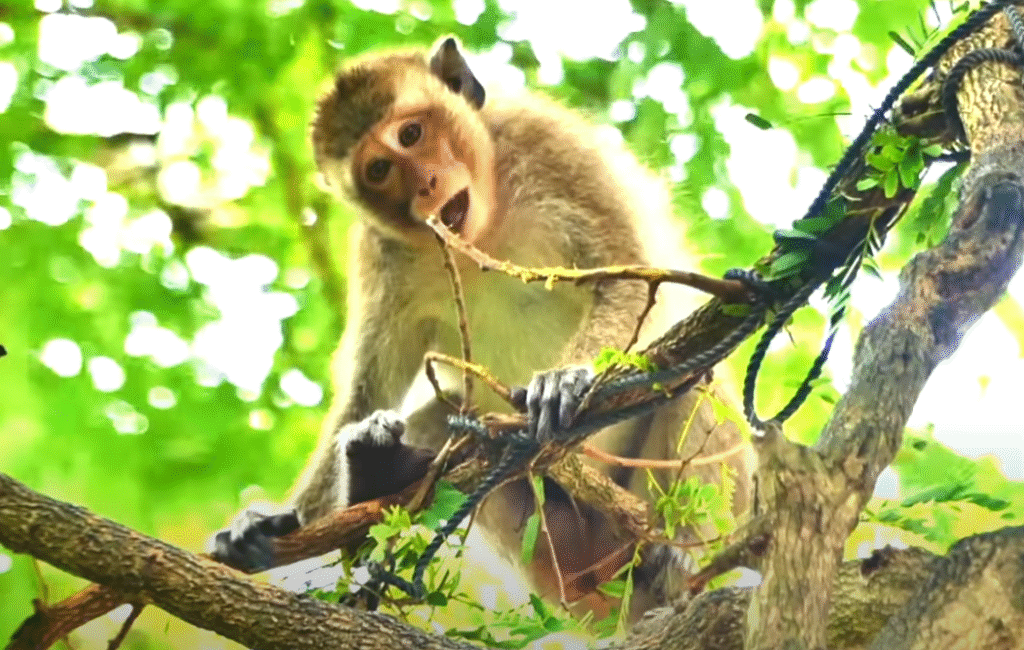

In the dense beauty of Angkor Wat’s ancient forest, the silence was broken by a tiny, muffled cry. It wasn’t the call of a bird, nor the howl of a wild macaque—it was something softer, more helpless. As I stepped closer through the underbrush, I saw him—a baby monkey tangled painfully in a thick cow rope, suspended awkwardly on a tree limb. His tiny arms flailed in confusion. His eyes, wide with fear, scanned the forest for help that wouldn’t come fast enough.
No one knows exactly how he got there. Maybe he’d been playing near the village edge, too curious for his own good. Maybe the rope was left from someone gathering firewood or feeding cattle nearby. But what mattered now was that his tiny body was stuck, the rough fibers of the rope tightening around his delicate frame.
He screamed—not the kind of scream that demands attention out of anger, but the kind that tears straight into your chest. His legs dangled, and the more he struggled, the tighter the rope cinched. Each twist of his body looked like a silent cry for his mother, who was nowhere in sight. The rope looped around his middle, pinning one of his arms, leaving him swinging weakly from the high branch—helpless, scared, and completely alone.
For what felt like forever, I just stood frozen—watching, heart pounding. Then instinct kicked in.
We gathered what we could. A nearby team of local wildlife supporters and a few kindhearted villagers responded quickly. One climbed up with incredible care while the rest of us held our breath from below, unsure if the branch would hold, unsure if the baby would even survive long enough to be freed.
His little body had already grown limp from exhaustion by the time help reached him. The rescuer carefully unwrapped the rope, inch by inch. Every second mattered. One wrong move and he could fall.
Finally, after what felt like an eternity, the rescuer cradled the baby monkey in his arm and began the slow, careful descent. We all watched in silence.
When they reached the ground, the baby barely moved. His breathing was faint, his limbs limp. But as he was gently laid on a bed of leaves, his eyes opened slowly—and in that moment, we saw the tiniest flicker of hope.
He wasn’t gone. Not yet.
We rushed him to a local wildlife caretaker nearby, where he was checked and treated for rope burns, bruises, and exhaustion. Incredibly, there were no broken bones—just deep rope impressions across his tiny belly and a soul shaken to its core.
Over the following days, he was kept warm, fed carefully, and gently cleaned. And though still weak, he slowly began to sit up, gripping small branches again, his strength returning like a flame finding oxygen. The soft grunts he made sounded like gratitude, or maybe just relief.
But the most unforgettable moment? When his mother returned.
It was three days after the rescue. We were sitting nearby when a wild female appeared—hesitant, cautious, eyes scanning the group. She didn’t cry out or run. Instead, she moved slowly, inching toward the enclosure. The baby chirped once. Just once.
She responded immediately. Her cry pierced the forest.
The moment they reunited was nothing short of magic. She rushed to him and wrapped him in her arms, checking every inch of him. He clung to her tightly, trembling still, but whole.
That baby monkey survived—and thrived—because a handful of strangers couldn’t bear to look away. Because even in the wildest corners of the world, a life this small matters.
And now, whenever I pass that tree, I look up and remember what we almost lost.